User Walking Speed and Standing Posture Influence Head/Neck Flexion and Viewing Behavior While Using a Smartphone
Abstract
:1. Introduction
2. Methods and Materials
2.1. Participants
2.2. Posture Measurement
2.3. Design and Procedure
2.4. Statistical Analysis
3. Results
4. Discussion
5. Conclusions
Author Contributions
Funding
Institutional Review Board Statement
Informed Consent Statement
Data Availability Statement
Acknowledgments
Conflicts of Interest
References
- Sela, A.; Rozenboim, N.; Ben-Gal, H.C. Smartphone use behavior and quality of life: What is the role of awareness? PLoS ONE 2022, 17, e0260637. [Google Scholar] [CrossRef] [PubMed]
- Gökçearslan, Ş.; Mumcu, F.K.; Haşlaman, T.; Çevik, Y.D. Modelling smartphone addiction: The role of smartphone usage, self-regulation, general self-efficacy and cyberloafing in university students. Comput. Hum. Behav. 2016, 63, 639–649. [Google Scholar] [CrossRef]
- Yoon, W.; Choi, S.; Han, H.; Shin, G. Neck muscular load when using a smartphone while sitting, standing, and walking. Hum. Factors 2021, 63, 868–879. [Google Scholar] [CrossRef] [PubMed]
- Han, H.; Shin, G. Head flexion angle when web-browsing and texting using a smartphone while walking. Appl. Ergon. 2019, 81, 102884. [Google Scholar] [CrossRef]
- Chen, Y.L.; Chen, K.H.; Cheng, Y.C.; Chang, C.C. Field study of postural characteristics of standing and seated smartphone use. Int. J. Environ. Res. Public Health 2022, 19, 4583. [Google Scholar] [CrossRef]
- Hansraj, K.K. Assessment of stresses in the cervical spine caused by posture and position of the head. Surg. Technol. Int. 2014, 25, 277–279. [Google Scholar]
- AlAbdulwahab, S.S.; Kachanathu, S.J.; AlMotairi, M.S. Smartphone use addiction can cause neck disability. Musculoskelet. Care 2017, 15, 10–12. [Google Scholar] [CrossRef]
- Warda, D.G.; Nwakibu, U.; Nourbakhsh, A. Neck and upper extremity musculoskeletal symptoms secondary to maladaptive postures caused by cell phones and backpacks in school-aged children and adolescents. Healthcare 2023, 11, 819. [Google Scholar] [CrossRef]
- Kramer, I.; Bauer, D.; Paulus, D. Holistic approach for markerless head-neck posture assessment. J. Head Neck Spine Surg. 2022, 4, 54–62. [Google Scholar] [CrossRef]
- Lee, S.; Kang, H.; Shin, G. Head flexion angle while using a smartphone. Ergonomics 2015, 58, 220–226. [Google Scholar] [CrossRef]
- Cromwell, R.L.; Aadland-Monahan, T.K.; Nelson, A.T.; SternSylvestre, S.M.; Seder, B. Sagittal plane analysis of head, neck, and trunk kinematics and electromyographic activity during locomotion. J. Orthop. Sports Phys. Ther. 2001, 31, 255–262. [Google Scholar] [CrossRef] [PubMed]
- Yuan, K.; Zhu, H.; Mou, Y.; Wu, Y.; He, J.; Huang, X.; Jin, X. Effects on the ocular surface from reading on different smartphone screens: A prospective randomized controlled study. Clin. Transl. Sci. 2021, 14, 829–836. [Google Scholar] [CrossRef] [PubMed]
- Kim, S.H.; Jung, J.H.; Shin, H.J.; Hahm, S.C.; Cho, H.Y. The impact of smartphone use on gait in young adults: Cognitive load vs posture of texting. PLoS ONE 2020, 15, e0240118. [Google Scholar] [CrossRef]
- Golebiowski, B.; Long, J.; Harrison, K.; Lee, A.; Chidi-Egboka, N.; Asper, L. Smartphone use and effects on tear film, blinking and binocular vision. Curr. Eye Res. 2020, 45, 428–434. [Google Scholar] [CrossRef] [PubMed]
- Hu, Q.; Li, Y.; Wang, B.; Qin, X.; Ren, T.; Hu, Y.; Li, X. The correlation between near vision and smartphone use among ageing populations. Ann. Palliat. Med. 2022, 11, 56067–56567. [Google Scholar] [CrossRef]
- Khan, M.R.; Ambati, T. Musculoskeletal pain symptoms in users performing smartphone texting: A preliminary study on institute environment. Int. J. Ind. Ergon. 2022, 90, 103325. [Google Scholar] [CrossRef]
- Chidi-Egboka, N.C.; Jalbert, I.; Golebiowski, B. Smartphone gaming induces dry eye symptoms and reduces blinking in school-aged children. Eye 2023, 37, 1342–1349. [Google Scholar] [CrossRef]
- Choi, J.H.; Kim, K.S.; Kim, H.J.; Joo, S.J.; Cha, H.G. Factors influencing on dry eye symptoms of university students using smartphone. Int. J. Pure Appl. Math. 2018, 118, 1–13. [Google Scholar] [CrossRef]
- Guan, X.; Fan, G.; Chen, Z.; Zeng, Y.; Zhang, H.; Hu, A.; Gu, G.; Wu, X.; Gu, X.; He, S. Gender difference in mobile phone use and the impact of digital device exposure on neck posture. Ergonomics 2016, 59, 1453–1461. [Google Scholar] [CrossRef]
- Vahedi, Z.; Mazloumi, A.; Sharifnezhad, A.; Kazemi, Z.; Garosi, E. Head forward flexion, lateral bending and viewing distance in smartphone users: A comparison between sitting and standing postures. Work 2020, 67, 837–846. [Google Scholar] [CrossRef]
- Chen, Y.L.; Chan, Y.C. Neck and shoulder strains under various head flexing positions while standing and sitting with and without back support for male and female smartphone users. Ergonomics 2023, 66, 1–12. [Google Scholar] [CrossRef]
- Namwongsa, S.; Puntumetakul, R.; Neubert, M.S.; Boucaut, R. Effect of neck flexion angles on neck muscle activity among smartphone users with and without neck pain. Ergonomics 2019, 62, 1524–1533. [Google Scholar] [CrossRef] [PubMed]
- Fercho, J.; Krakowiak, M.; Yuser, R.; Szmuda, T.; Zieliński, P.; Szarek, D.; Miękisiak, G. Kinematic analysis of the forward head posture associated with smartphone use. Symmetry 2023, 15, 667. [Google Scholar] [CrossRef]
- Brühl, M.; Hmida, J.; Tomschi, F.; Cucchi, D.; Wirtz, D.C.; Strauss, A.C.; Hilberg, T. Smartphone use—Influence on posture and gait during standing and walking. Healthcare 2023, 11, 2543. [Google Scholar] [CrossRef] [PubMed]
- Kaur, K.; Gurnani, B.; Nayak, S.; Deori, N.; Kaur, S.; Jethani, J.; Singh, D.; Agarkar, S.; Hussaindeen, J.R.; Sukhija, J.; et al. Digital eye strain—A comprehensive review. Ophthal. Ther. 2022, 11, 1655–1680. [Google Scholar] [CrossRef] [PubMed]
- Boccardo, L.; Gurioli, M.; Grasso, P.A. Viewing distance and character size in the use of smartphones across the lifespan. PLoS ONE 2023, 18, e0282947. [Google Scholar] [CrossRef]
- Bababekova, Y.; Rosenfield, M.; Hue, J.E.; Huang, R.R. Font size and viewing distance of handheld smart phones. Optom. Vis. Sci. 2011, 88, 795–797. [Google Scholar] [CrossRef]
- Long, J.; Rosenfield, M.; Helland, M.; Anshel, J. Visual ergonomics standards for contemporary office environments. Ergon. Aust. 2014, 10, 7. [Google Scholar]
- Tosha, C.; Borsting, E.; Ridder, W.H., III; Chase, C. Accommodation response and visual discomfort. Ophthalmic Physiol. Opt. 2009, 29, 625–633. [Google Scholar] [CrossRef]
- Rosenfield, M. Computer vision syndrome: A review of ocular causes and potential treatments. Ophthalmic Physiol. Opt. 2011, 31, 502–515. [Google Scholar] [CrossRef]
- Ha, A.; Kim, Y.K.; Park, Y.J.; Jeoung, J.W.; Park, K.H. Intraocular pressure change during reading or writing on smartphone. PLoS ONE 2018, 13, e0206061. [Google Scholar] [CrossRef] [PubMed]
- Long, J.; Cheung, R.; Duong, S.; Paynter, R.; Asper, L. Viewing distance and eyestrain symptoms with prolonged viewing of smartphones. Clin. Exp. Optom. 2017, 100, 133–137. [Google Scholar] [CrossRef]
- Niebel, B.W.; Freivalds, A. Niebel’s Methods, Standards, and Work Design; McGraw-Hill: New York, NY, USA, 2014. [Google Scholar]
- Merbah, J.; Gorce, P.; Jacquier-Bret, J. Interaction with a smartphone under different task and environmental conditions: Emergence of users’ postural strategies. Int. J. Ind. Ergon. 2020, 77, 102956. [Google Scholar] [CrossRef]
- Brink, Y.; Louw, Q.; Grimmer, K.; Jordaan, E. The spinal posture of computing adolescents in a real-life setting. BMC Musculoskelet. Disord. 2014, 15, 212. [Google Scholar] [CrossRef] [PubMed]
- Korakakis, V.; O’Sullivan, K.; Whiteley, R.; O’Sullivan, P.B.; Korakaki, A.; Kotsifaki, A.; Tsaklis, P.V.; Tsiokanos, A.; Giakas, G. Notions of “optimal” posture are loaded with meaning. Perceptions of sitting posture among asymptomatic members of the community. Musculoskelet. Sci. Pract. 2021, 51, 102310. [Google Scholar] [CrossRef]
- Boccardo, L. Viewing distance of smartphones in presbyopic and non-presbyopic age. J. Optom. 2021, 14, 120–126. [Google Scholar] [CrossRef]
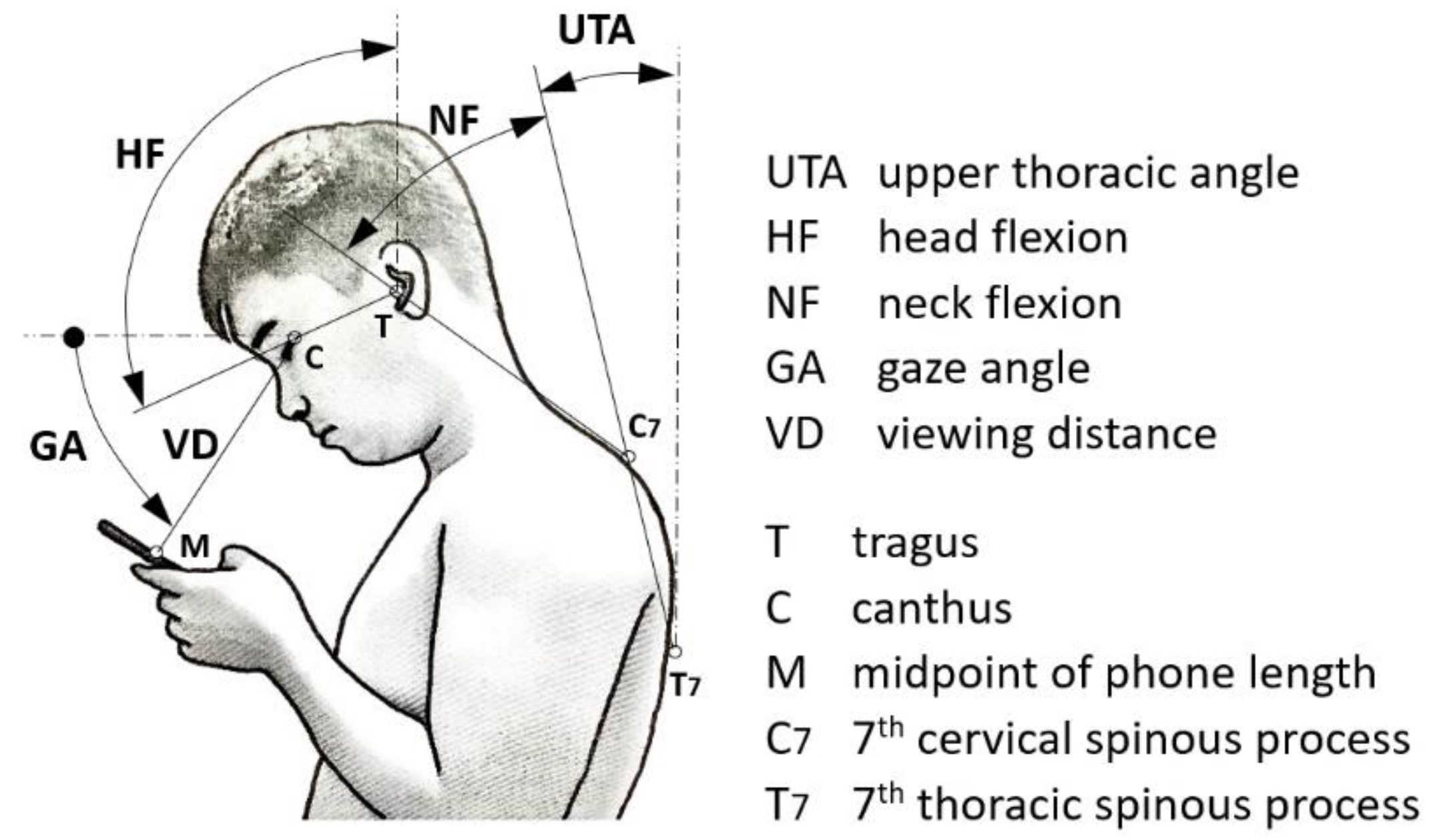
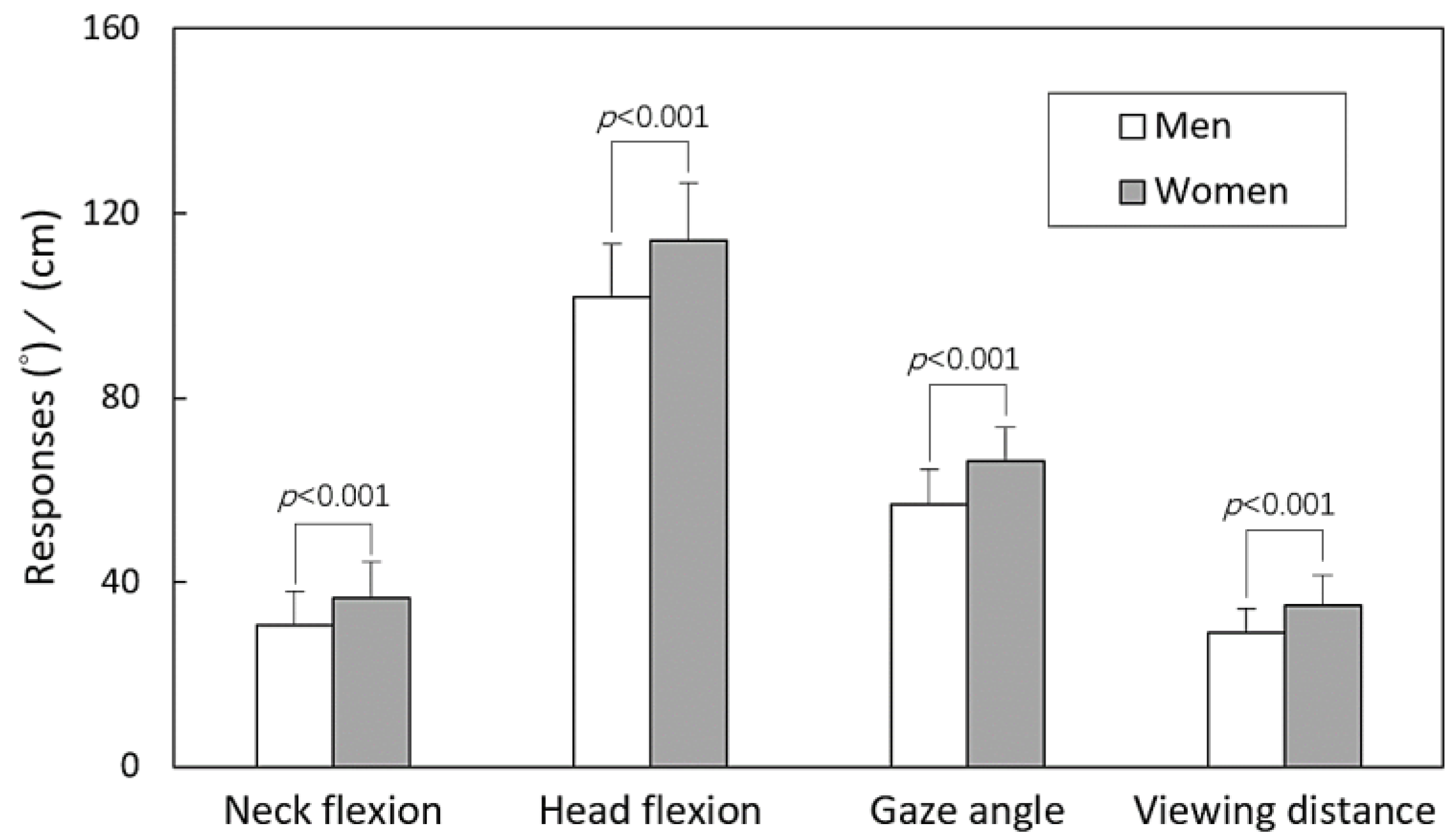
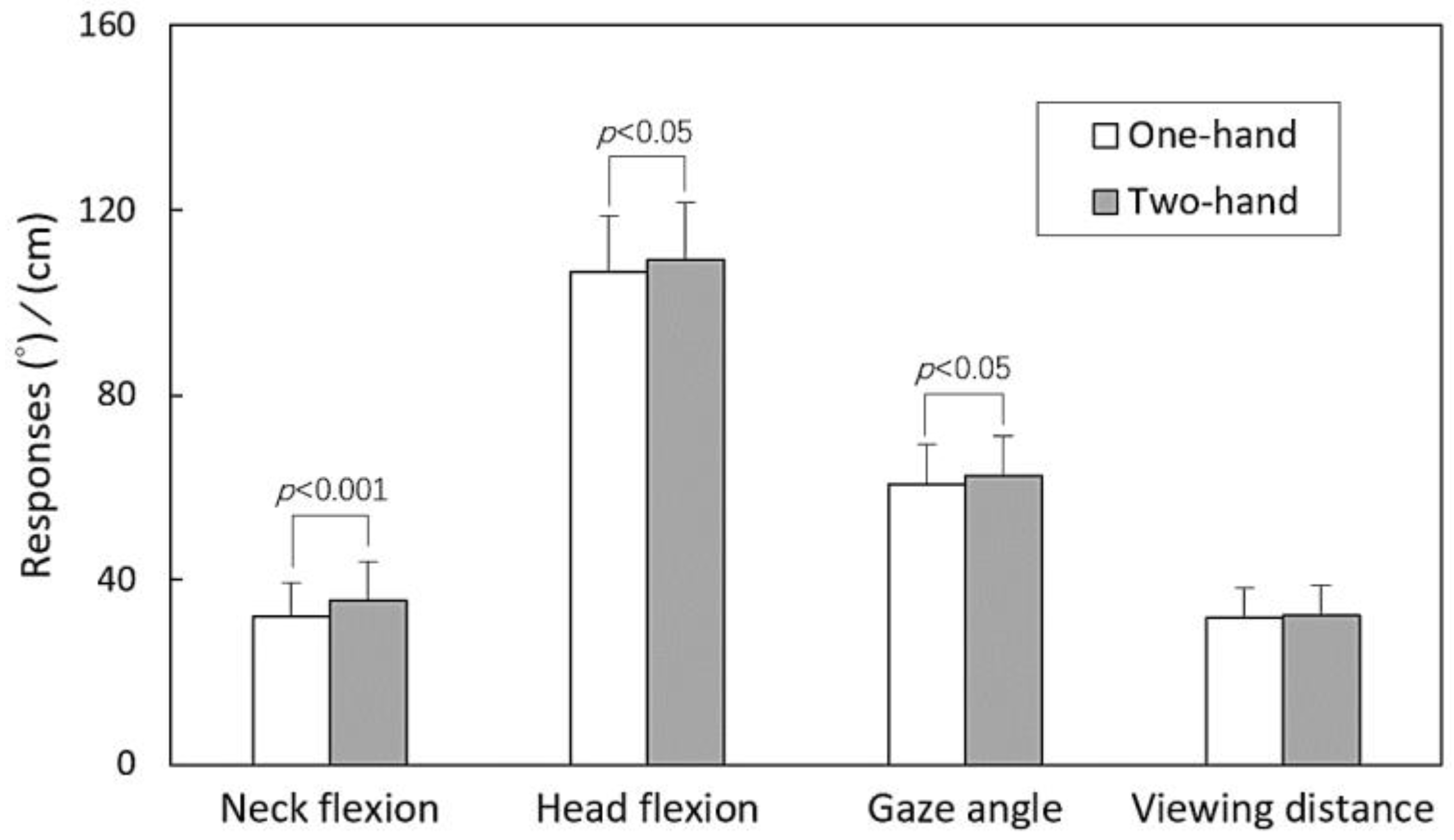
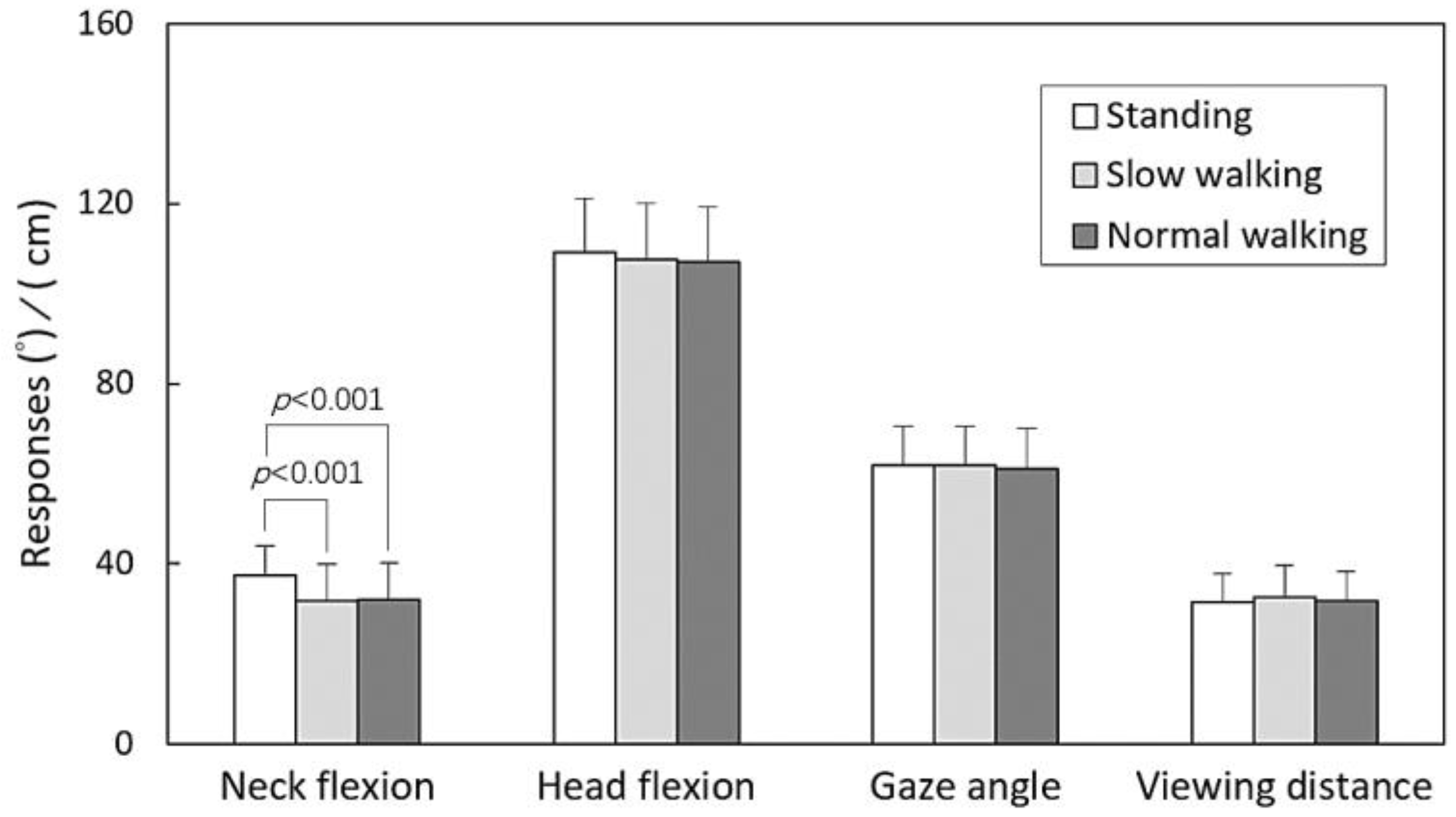
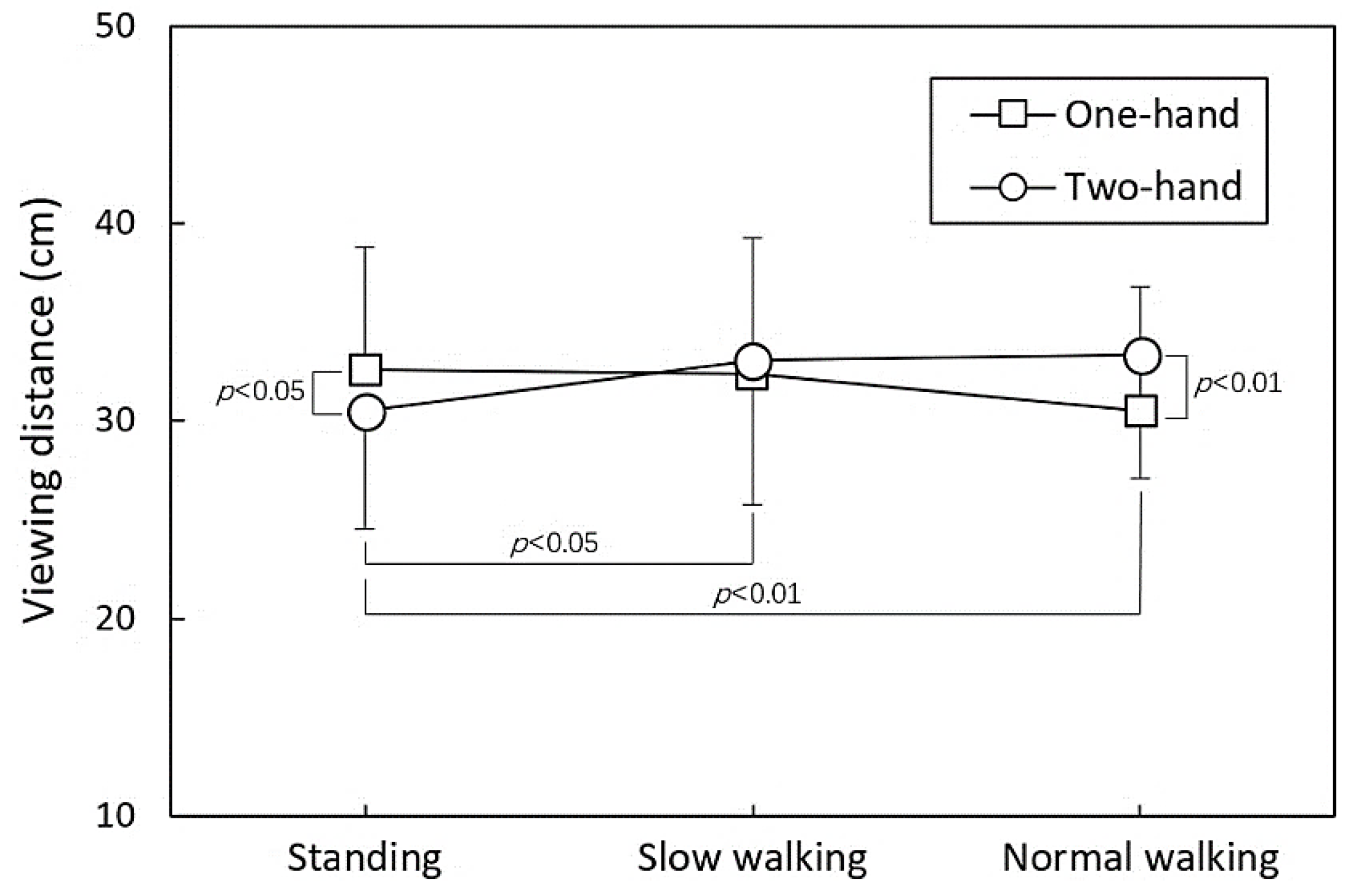
| Men (n = 30) | Women (n = 30) | |||
|---|---|---|---|---|
| Items | Mean | Standard Deviation | Mean | Standard Deviation |
| Age (years) | 21.7 | 1.8 | 22.4 | 2.4 |
| Height (cm) | 173.8 | 6.8 | 160.0 | 6.1 |
| Body mass (kg) | 70.4 | 5.0 | 54.7 | 4.9 |
| Variables | Responses | SS | DF | MS | F | p |
|---|---|---|---|---|---|---|
| Sex | Neck flexion | 2915 | 1 | 2915 | 58.7 | <0.001 |
| Head flexion | 13,827 | 1 | 13,827 | 123.6 | <0.001 | |
| Gaze angle | 7660 | 1 | 7660 | 136.8 | <0.001 | |
| Viewing distance | 3326 | 1 | 3326 | 97.6 | <0.001 | |
| Hand operation | Neck flexion | 1061 | 1 | 1061 | 21.4 | <0.001 |
| Head flexion | 736 | 1 | 736 | 6.6 | <0.05 | |
| Gaze angle | 347 | 1 | 347 | 6.2 | <0.05 | |
| Viewing distance | 23 | 1 | 23 | 0.7 | 0.408 | |
| Posture | Neck flexion | 2293 | 2 | 1147 | 23.1 | <0.001 |
| Head flexion | 334 | 2 | 167 | 1.5 | 0.226 | |
| Gaze angle | 30 | 2 | 15 | 0.3 | 0.764 | |
| Viewing distance | 87 | 2 | 43 | 1.3 | 0.281 | |
| Sex × hand operation | Neck flexion | 1 | 1 | 1 | <0.1 | 0.905 |
| Head flexion | 21 | 1 | 21 | 0.2 | 0.668 | |
| Gaze angle | 67 | 1 | 67 | 1.2 | 0.275 | |
| Viewing distance | 20 | 1 | 20 | 0.6 | 0.440 | |
| Sex × posture | Neck flexion | 38 | 2 | 19 | 0.4 | 0.684 |
| Head flexion | 71 | 2 | 35 | 0.3 | 0.728 | |
| Gaze angle | 10 | 2 | 5 | 0.1 | 0.918 | |
| Viewing distance | 24 | 2 | 12 | 0.4 | 0.705 | |
| Hand operation × posture | Neck flexion | 26 | 2 | 13 | 0.3 | 0.773 |
| Head flexion | 334 | 2 | 167 | 1.5 | 0.226 | |
| Gaze angle | 18 | 2 | 9 | 0.2 | 0.851 | |
| Viewing distance | 371 | 2 | 185 | 5.4 | <0.01 | |
| Sex × hand operation × posture | Neck flexion | 18 | 2 | 9 | 0.2 | 0.837 |
| Head flexion | 8 | 2 | 4 | <0.1 | 0.964 | |
| Gaze angle | 71 | 2 | 35 | 0.6 | 0.532 | |
| Viewing distance | 7 | 2 | 4 | 0.1 | 0.902 |
Disclaimer/Publisher’s Note: The statements, opinions and data contained in all publications are solely those of the individual author(s) and contributor(s) and not of MDPI and/or the editor(s). MDPI and/or the editor(s) disclaim responsibility for any injury to people or property resulting from any ideas, methods, instructions or products referred to in the content. |
© 2023 by the authors. Licensee MDPI, Basel, Switzerland. This article is an open access article distributed under the terms and conditions of the Creative Commons Attribution (CC BY) license (https://creativecommons.org/licenses/by/4.0/).
Share and Cite
Chen, Y.-L.; Nguyen, H.-T. User Walking Speed and Standing Posture Influence Head/Neck Flexion and Viewing Behavior While Using a Smartphone. Healthcare 2023, 11, 3027. https://doi.org/10.3390/healthcare11233027
Chen Y-L, Nguyen H-T. User Walking Speed and Standing Posture Influence Head/Neck Flexion and Viewing Behavior While Using a Smartphone. Healthcare. 2023; 11(23):3027. https://doi.org/10.3390/healthcare11233027
Chicago/Turabian StyleChen, Yi-Lang, and Hong-Tam Nguyen. 2023. "User Walking Speed and Standing Posture Influence Head/Neck Flexion and Viewing Behavior While Using a Smartphone" Healthcare 11, no. 23: 3027. https://doi.org/10.3390/healthcare11233027
APA StyleChen, Y.-L., & Nguyen, H.-T. (2023). User Walking Speed and Standing Posture Influence Head/Neck Flexion and Viewing Behavior While Using a Smartphone. Healthcare, 11(23), 3027. https://doi.org/10.3390/healthcare11233027






